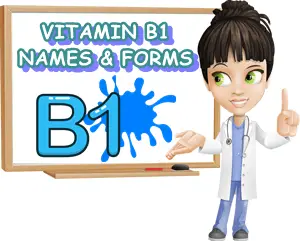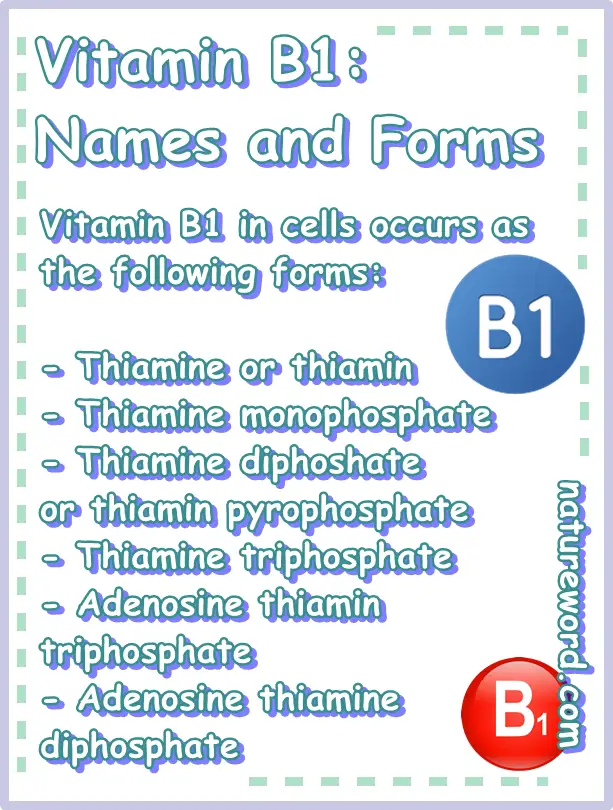Vitamin B1 is the common name for the first vitamin of the B vitamins group.
It was the first to be discovered and opens the B vitamins list.
Calling it vitamin B1 is accessible terminology as it does not require any knowledge of complex scientific jargon, whilst serving the main purpose of communication which is acquiring/providing information.
But what else is vitamin B1 called? What are its other names and what are the different forms?
B vitamins names: Vitamin B1
What most of us simply call vitamin B1 is actually thiamine. Thiamine, or its alternative spelling, thiamin, is the more scientific appellation that often appears on the back of dietary supplement labels alongside the more common name: ‘vitamin B1’.
Thiamine is actually the original name for vitamin B1, and is used to designate both natural vitamin B1, the form occurring naturally in food, as well as vitamin B1 from dietary supplements which is produced synthetically.
It was the first of the B vitamins to be discovered in 1897.

But that’s not the only name for it. Another name for vitamin B1 or thiamine is aneurine, but it’s less known to the general public.
To make things even more interesting, there are about 20 different actual forms of vitamin B1 (known so far).
Some of these forms occur naturally in food, and some have been developed synthetically in the lab for various medical applications. But they are all vitamin B1.
But there are about 20 different known forms of vitamin B1.
Despite being different in their chemical structure, albeit only slightly, all the different forms of vitamin B1 have vitamin B1 activity.
That means that they all treat vitamin B1 deficiency and associated diseases and symptoms, and perform vitamin B1-specific functions in the body. The difference is that some forms do it better than others.
The different forms of vitamin B1 are known as vitamers.
Vitamers of vitamin B1 are, by definition, molecular analogues of vitamin B1. Or more simple put, different forms or variants of vitamin B1.
They are very closely related in structure, but not identical to one another. Despite minor structural differences, all the different vitamers of vitamin B1 have vitamin B1 activity in the body.

The structural differences between vitamin B1 vitamers affect how well they perform vitamin B1-specific functions.
For example, the differences in structure, however minor, will affect how well a vitamin B1 form is absorbed (absorption rate), how much of it is retained in the body (retention rate), how well the body processes it and uses it for vitamin B1-specific functions and, ultimately, the end therapeutic efficacy.
Some vitamin B1 forms are better suited for specific uses and therapeutic activities. Some forms are meant to be taken in larger amounts and some in smaller amounts.
Some forms carry more potential for toxicity, whereas others pose no health risks and are generally very safe for use. Some forms can only be processed via specific pathways and that can affect their uptake and use by the body.
Some will produce more benefits or more measurable benefits than others.
Vitamin B1 forms: what qualifies as vitamin B1?
Vitamin B1 does not occur only as thiamine. There are actually about 20 different forms of vitamin B1 both occurring naturally in food and developed synthetically.
All the different forms of vitamin B1 serve the primary purpose of correcting a vitamin B1 deficiency, and the diseases and symptoms associated with it, but some are used as dietary supplements and some as pharmaceuticals/medication.
In cells, vitamin B1 occurs predominantly in the following forms:
- Thiamine or free thiamine
- Thiamine monophosphate (TMP)
- Thiamine diphoshate (ThDP) or thiamin pyrophosphate (TPP)
- Thiamine triphosphate (TTP)
- Adenosine thiamin triphosphate (AThTP) or thiaminylated adenosine triphosphate
- Adenosine thiamine diphosphate (AThDP) or thiaminylated adenosine diphosphate
Sources: source 1, source 2, source 3, source 4.
Other names for vitamin B1:
- Acefurtiamine – It has been used as an analgesic.
- Allithiamine – It is a naturally occurring form of vitamin B1 discovered in garlic and is soluble in fat which is unusual since vitamin B1 and all B vitamins are water-soluble vitamins.
- Benfotiamine – It is a synthetic form of vitamin B1 used primarily as medication for diabetes and Alzheimer’s; it has very low water solubility and high fat solubility.
- Fursultiamine – It was originally developed from Allithiamine and used as a dietary supplement and medication for the treatment of vitamin B1 deficiency and beri beri, the disease caused by severe vitamin B1 deficiency. It’s also soluble in fat.
- Octotiamine or Thioctothiamine – It is available commercially as Neuvita and Neuvitan.
- Prosultiamine – It was first discovered in garlic. It is available commercially as Jubedel. At one point it was studies as a potential treatment for human T-cell leukemia-lymphoma viruses, viruses that cause a form of leukemia.
- Sulbutiamine – It is a synthetic form of vitamin B1. It is available commercially as Arcalion and Enerion. It is used primarily as a dietary supplement for the treatment of vitamin B1 deficiency, but also for weakness and fatigue. This form of vitamin B1 has been found effective at raising levels of the vitamin in the brain.
These forms of vitamin B1 are known to serve specific medical applications in addition to being used for the treatment of vitamin B1 deficiency. For example, Acefurtiamine is an analgesic in larger doses.
Benfotiamine has been considered for the treatment of Alzheimer’s disease and nerve damage in diabetes, including kidney damage and peripheral tissue damage. In an animal study, treatment with Benfotiamine was found to ‘diminish plaques, decrease phosphorylation of tau and reverse memory deficits’ in mouse models of Alzheimer’s disease (source).
Sulbutiamine is commonly used for symptoms of weakness and fatigue, and reported to help with cognitive function, helping improve memory, concentration and boost productivity. Its use as a brain supplement has been theorized to be a result of its effectiveness at raising levels of vitamin B1 in the brain.
